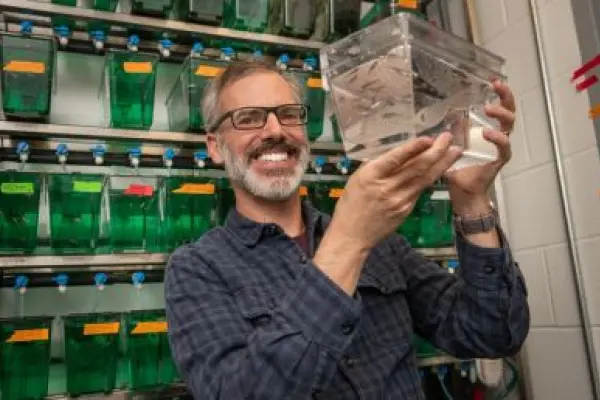
Posner continues to study eyes using zebrafish
It doesn’t take long to see that Mason Posner likes zebrafish.
The Ashland University biology professor has a drawing of one wearing a Santa hat on his office door.
“There was one year our biology student group for Christmas made these pictures of the organisms we each work on and they gave them to us,” Posner said with a smile.
So that all people can see drawings like Posner’s is the main reason he works with the small freshwater fish from South Asia and did his recent study leave work on its benefits to eye research.
With the help of four students, Posner did gene-editing research during the fall 2021 semester on zebrafish, which builds its lens in a similar way to humans.
Posner has been studying zebrafish since his post-doctoral days at UCLA in 1998, bringing that research to Ashland the following year when he joined the AU faculty. He and his students have been working with zebrafish ever since – always eye research.
“Most of my students don’t keep doing zebrafish research, but there have been a couple,” Posner said about one who did his post-doctorate work with zebrafish at the Cleveland Clinic and another who had a research job with the National Institute of Health (NIH) using the small fish to study brain development before she went on to work in public health.
Grant funding through the NIH has helped Posner since 2002 with his research on zebrafish, which he said has been a valuable model species for all kinds of research – drug testing, toxicology, environmental science; eyes, livers and brains; to name a few.
“There are thousands of people worldwide who work on zebrafish,” said Posner, who attends a national eye research meeting annually and zebrafish conferences regularly.
All three of Posner’s study leave work have been with eye research using zebrafish. The most recent one included damaging lens-related genes to try to better understand their effects on lens development.
“Surprisingly, we found that a gene previously reported in the literature to be important for lens development had no effect when damaged, placing into question these past findings,” Posner said during his Faculty College presentation in August. “However, our study found that a second gene did lead to lens defects when damaged, and we produced a detailed atlas of those different defects.”
Posner and the four students involved with the research also looked for new genes in lens development, something three current students are researching. One of the students who focused her honors capstone research on this study leave work project discovered two new genes that have potential to be part of lens development, Posner said.
“It’s fun to work with students,” Posner said. “We do these experiments and are probably the first people to realize this a piece of the puzzle that no one knew before. Students find that exciting.”
The students presented at URCA - Undergraduate Research and Creative Activity symposium, an annual mini-conference on campus for students to present research, artwork and other projects. The research also is expected to be published this fall in the Experimental Eye Research journal.
The hope is this research will eventually help prevent or treat blinding diseases like cataracts, Posner said.
“Our work is the basic science work,” he said. “We’re not designing drugs. We’re just trying to understand the basics of how eye lenses work. That is helpful to people who eventually come up with medical interventions.”
Ashland University is a mid-sized, private university conveniently located a short distance from Akron, Cleveland and Columbus, Ohio. Ashland University (www.ashland.edu) values the individual student and offers a unique educational experience that combines the challenge of strong applied academic programs with a faculty and staff who build nurturing relationships with their students.